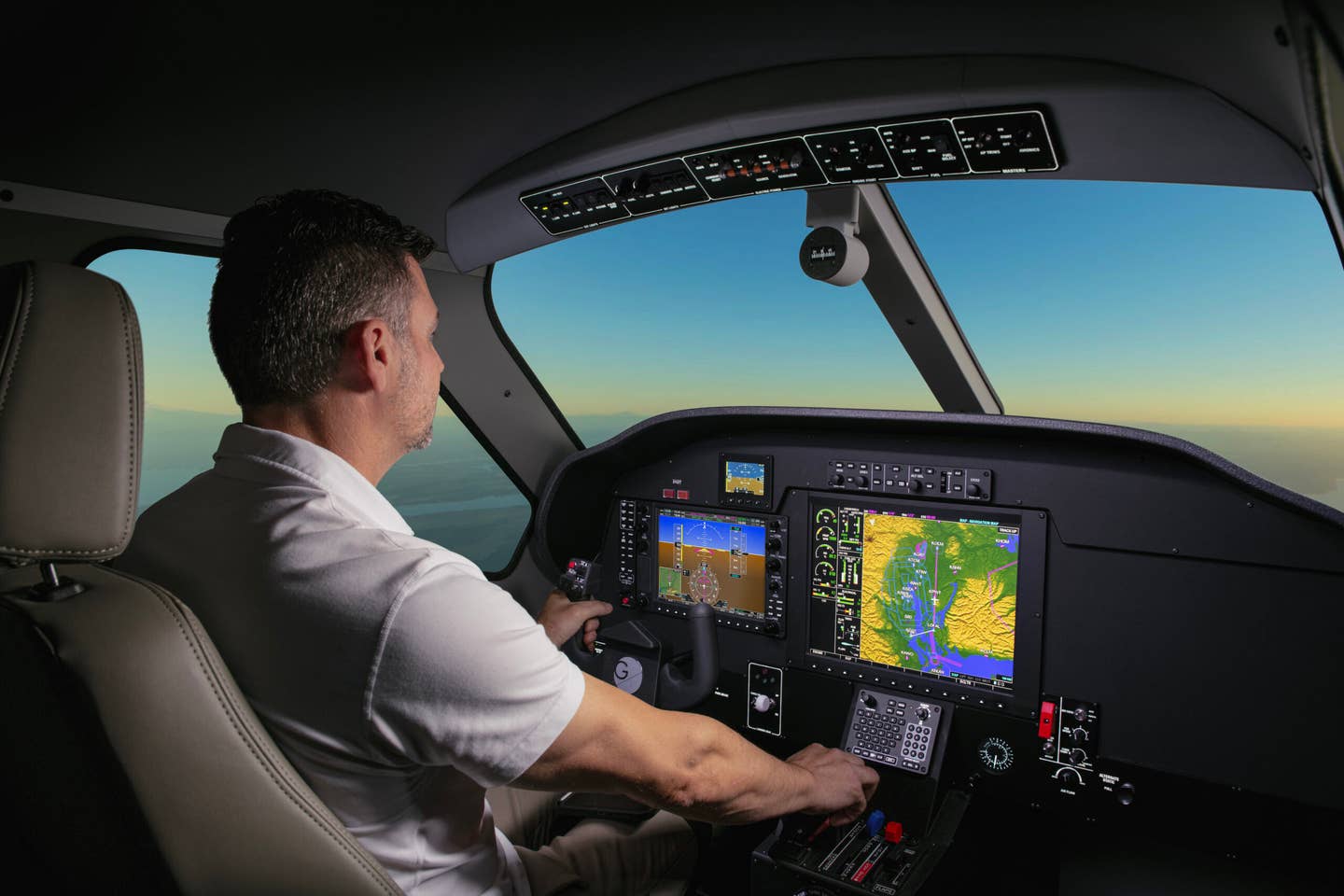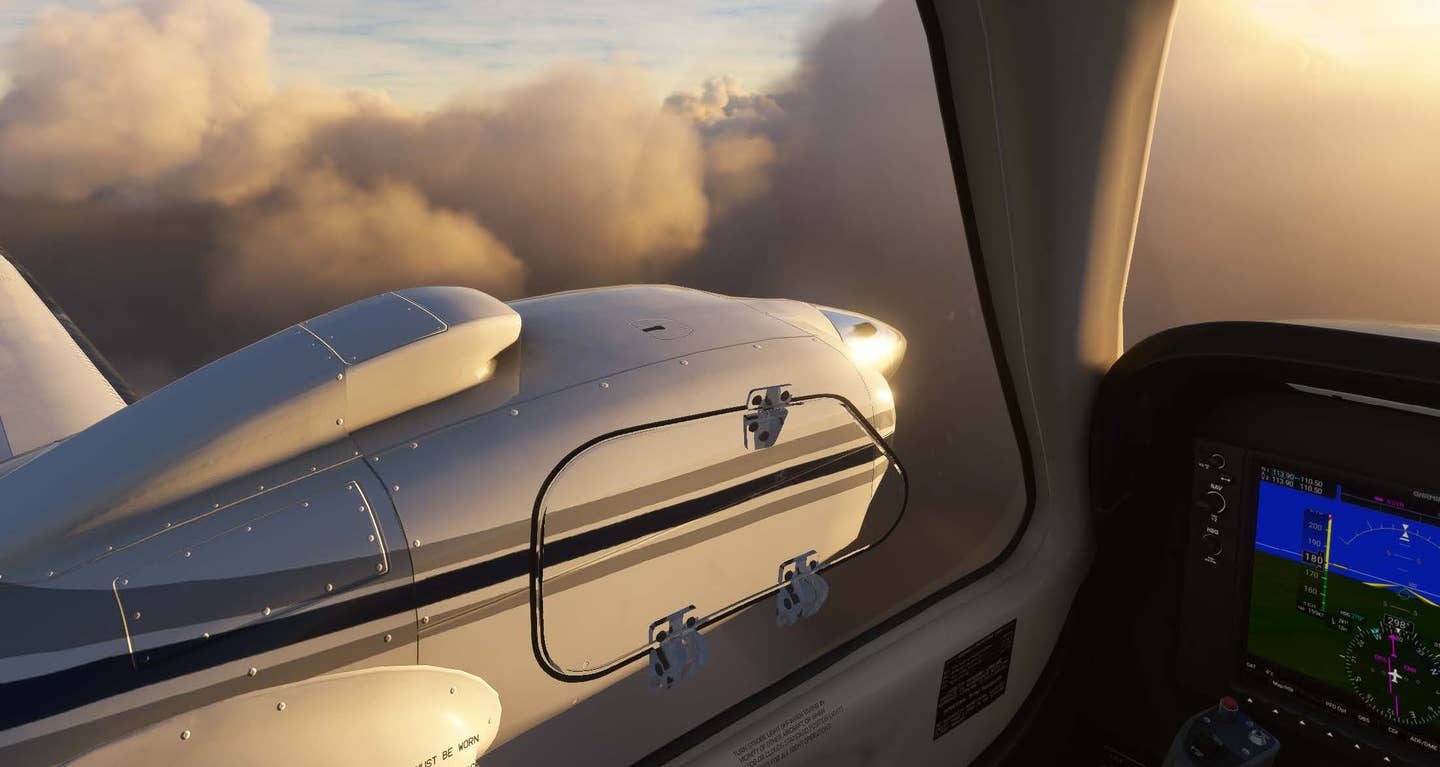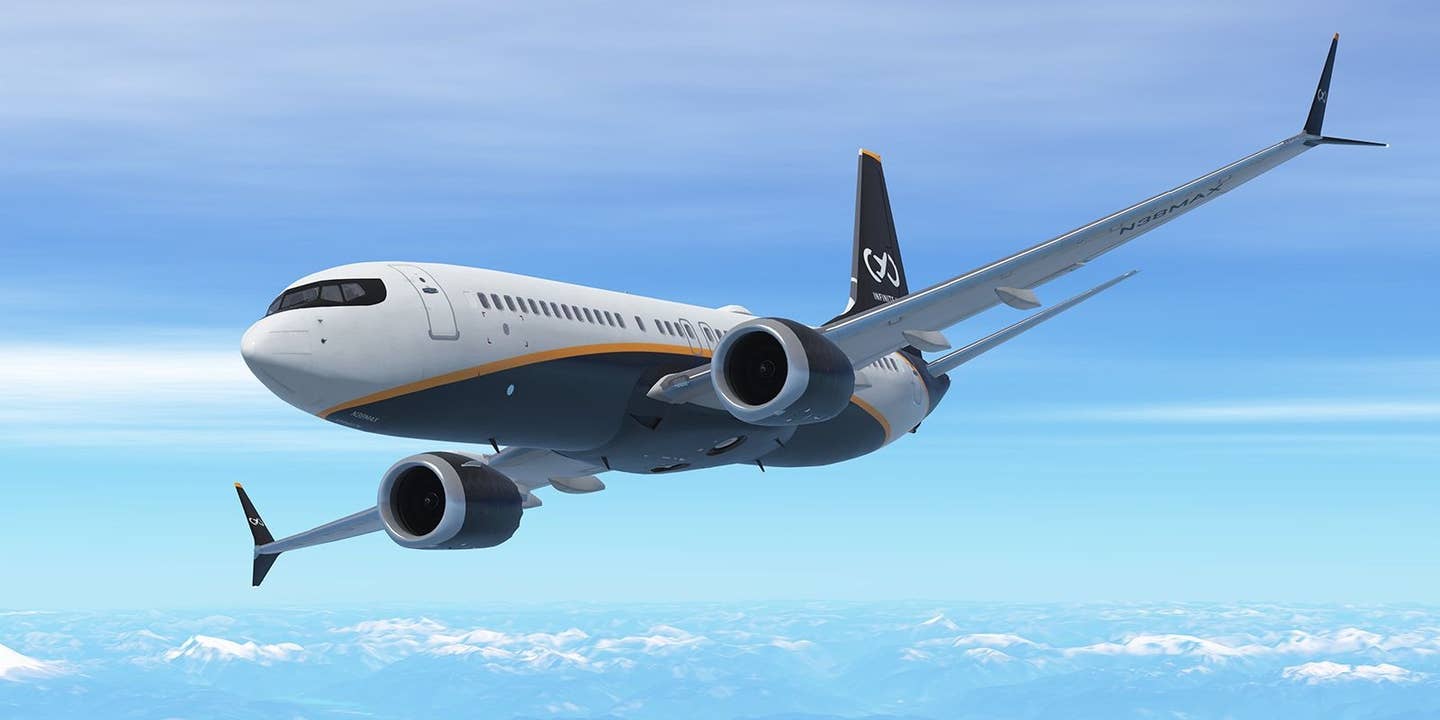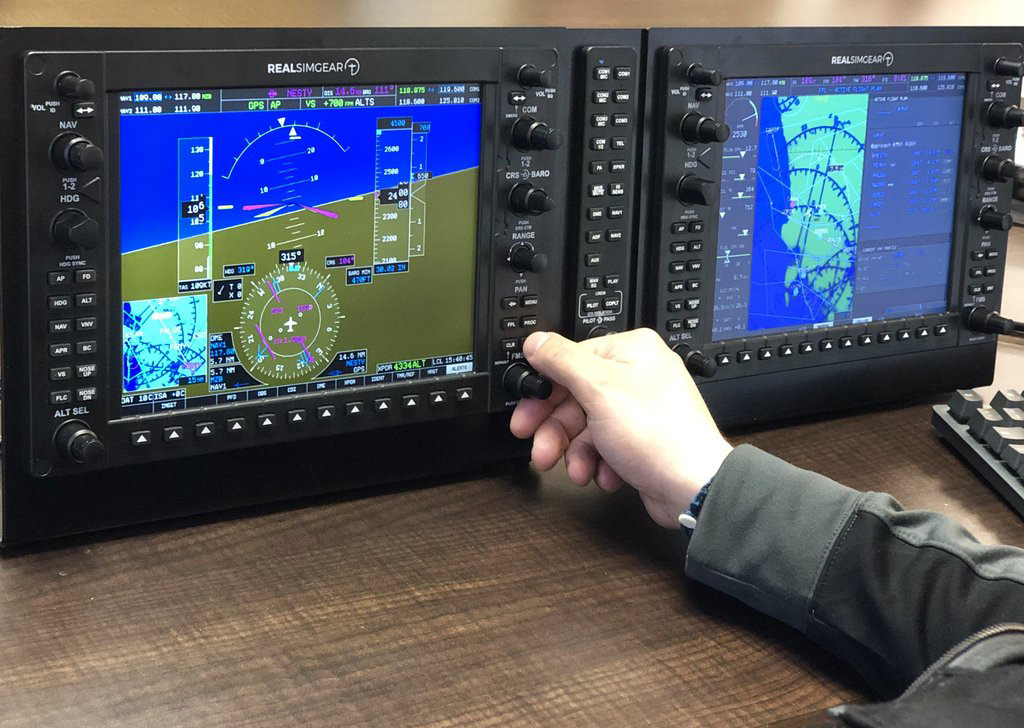Exploring the Checkered History of the Lockheed F-104 Starfighter
The Cold War-era fighter jet demonstrated that speed isn’t everything.
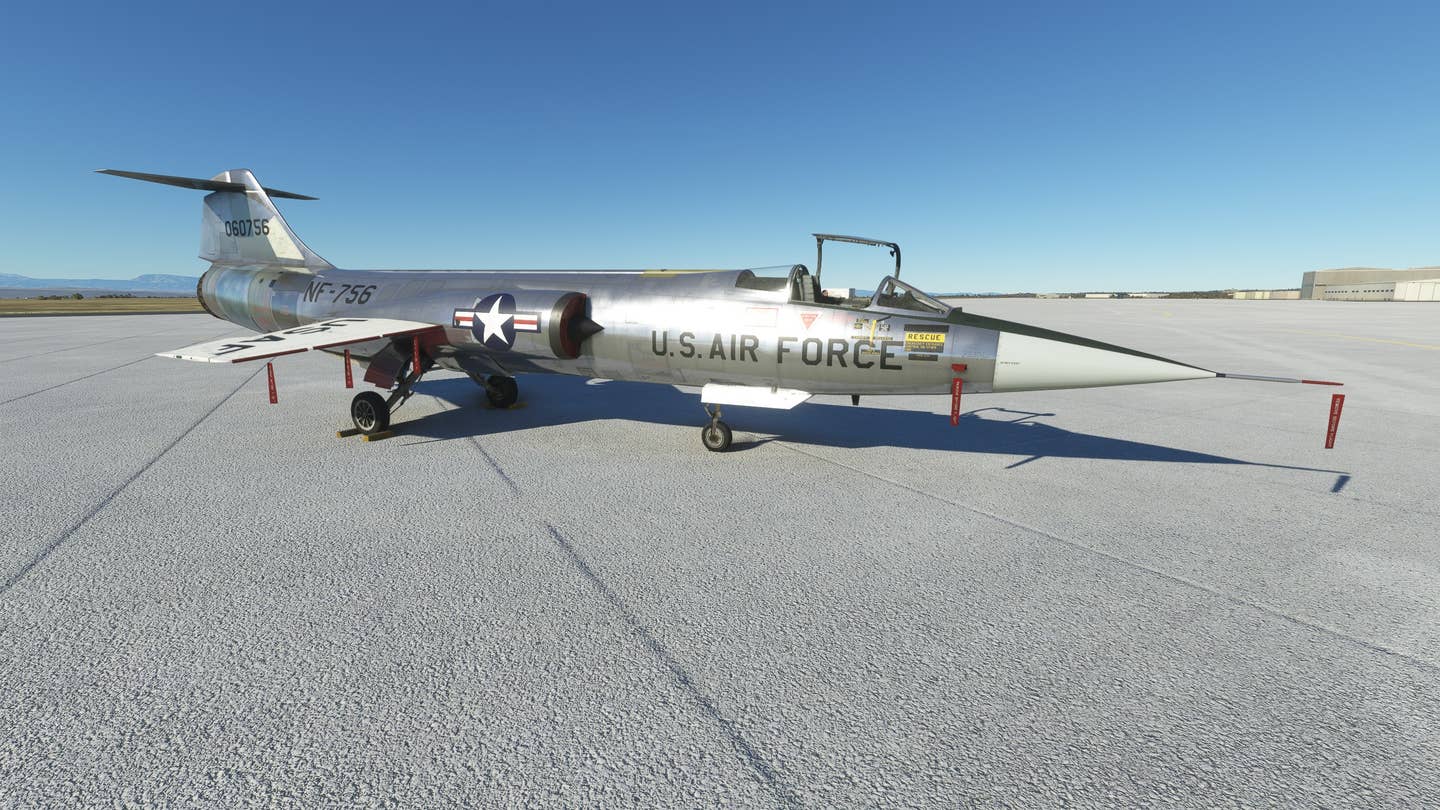
The F-104 prototype took to the skies in March 1954. [Courtesy: Patrick Chovanec]
Today in Microsoft Flight Simulator 2020 (MSFS2020), I’ll be flying the Lockheed F-104 Starfighter, a Cold War airplane with a checkered history that demonstrated that speed isn’t everything.
To kick us off, I’m at Edwards Air Force Base in California’s Mojave Desert, with a reincarnation of the same plane that Chuck Yeager crashed trying to set a new altitude record here in 1963.
The story of the F-104 begins in the skies over Korea, where U.S. pilots in F-86 Sabres battled MiG-15s, many of them secretly flown by Russian pilots. While the F-86 held its own, pilots reported that they wanted a jet fighter that could fly faster and higher than the MiG. The challenge was taken up by Kelly Johnson, the famous head of Lockheed’s Skunk Works, who designed many of the company’s most groundbreaking planes, including the L-10 Electra and P-38 Lighting, and later the U-2 and SR-71 Blackbird spy planes.
The F-104 Starfighter would be propelled by a single General Electric J79 jet engine, an absolute monster that produced over 14,000 pounds of thrust. The main wings of the F-104 were stubby, extremely thin, and tilted downward (anhedral) as a counter to the T-tail behind. The forward edges of the wings were so sharp they created a safety hazard to ground crew—accidentally bang into them, and they could cut like a knife.
When flying at high angles of attack, the wings could potentially mask the T-tail from the airflow, rendering the elevators useless and making it impossible to pitch down to recover—something I learned I really had to watch out for.
The cockpit is all analog gauges. The most important are the artificial horizon to the middle right, the altimeter to the middle left, and the airspeed indicator just above it. The engine gauges to the far right are important too, because this thing is easy to overheat.
The throttle to the left is pretty simple. Just next to it is the level for flaps. There’s only one stage of flaps, about 10 degrees, for takeoff and landing.
The first F-104 prototype took to the skies in March 1954 at Edwards AFB and quickly earned its reputation as a “missile with a man on it.” In the first few months, the F-104 set numerous altitude and speed records, becoming the first jet fighter to exceed Mach 2.
But it also soon revealed a number of flaws and limitations that would plague it throughout its career. First, while it was extremely fast, it had a very wide turning radius, which made it unsuitable for close-in dogfighting. This became evident when I made a 180-degree turn to land and kept way overshooting the runway.
Second, when you have the engine on full throttle, it’s very easy for the compressor to stall and cause the engine to flame out. This happened several times, throwing me violently forward in the cockpit. I was high enough, so I could restart.
Finally, there’s angle of attack, the angle at which the wing meets the air. The higher that angle, the more lift. But beyond a certain point the wing will stall and cease providing any lift at all. The angle of attack indicator is the dial to the far right. It’s on “3” here. When it goes to “5” or more, the stick starts shaking to warn me. And if it goes into the red, the stick will automatically push forward, causing the airplane to lurch nose down.
At first, I found it a challenge to manage the angle of attack at speeds below 200 knots. In fact, that’s why the F-104 was known for having to land at a relatively fast speed. In fact, this was the result of my first attempt to land it. Needless to say, it was a closed-casket funeral.
For all these reasons, the F-104 was one of the first jet fighters to feature an ejection seat. Pull the cord down between my legs and away we go. F-104 pilots wore spurs, which clipped into wires that, when they ejected, pulled their legs in from the rudder pedals so they wouldn’t get ripped off. The pilots loved these because when they walked around it made them look and feel like cowboys.
The problem was the first explosive charges for the F-104’s ejection seat couldn’t propel the pilot above the oncoming T-tail. So the pilot was ejected downward out the bottom of the fuselage. Ejecting downward at high altitudes wasn’t a problem, but it became deadly at low altitudes on final approach. The ejection would slam you right into the ground before the parachute could open. Eventually this was changed, and new explosive charges were rigged to blow off the canopy and eject the pilot skyward, which has remained the practice ever since.
The F-104 is probably most familiar from the scene in the 1983 film The Right Stuff, where Yeager, played by Sam Shepard, tries to fly one to the edge of space and ends up losing control and ejecting just before it crashes. This was a real event, and the airplane he flew (NF-756) was actually an experimental version of the F-104 with a rocket (not depicted) attached to the tail, providing an additional boost to reach maximum altitude.
Yeager actually began his run level at 40,000 feet to build up speed to Mach 2.2 before starting his climb. Then he nosed up 45 degrees or more and shot for the sky. At 78,000 feet he shut off the main engine and let the tail rocket propel him higher.
In the movie, it makes it look like the problem was that his engine failed. In fact, that wasn’t the issue. The trouble was that around 107,000 feet for some reason the elevators became locked, and he couldn’t nose down as he lost speed. Unable to regain speed by nosing back down, the airplane went into a flat spin, and Yeager ultimately had to eject. The seat hit him and caused the rubber in his helmet to catch fire, burning his face and one of his fingers badly, but he survived.
I don’t have an extra tail rocket and was still learning the ropes with the finicky engine, so the highest I was able to go in the F-104 was to about 50,000 feet. The view was pretty wild, though. The fastest I could get the F-104 on my first flight was Mach 1.4. Though I think with a little practice I could probably figure out how to get past Mach 2.
Time to come back down to earth and try to land right this time. Barreling in at 200 knots is a little unnerving (a Cessna lands at about 60 knots, a Boeing 737 at about 130). Once you do touch down, the F-104 has a parachute you can deploy to help slow you down in time before you run out of runway. Later versions of the F-104 also featured a tailhook that could catch wires on certain airfields to come to a halt. Either way, even in the sim you definitely feel being slammed forward as you decelerate.
The F-104 was initially deployed as a high-speed interceptor and played a key deterrent role in the 1958 Taiwan Straits Crisis, the 1961 Berlin Wall Crisis, and the 1962 Cuban Missile Crisis. But the limitations of the F-104 in an actual combat role became evident during the Vietnam War, which is why I’m at the giant U.S. airbase at Da Nang (now a civilian airport, VVDN).
One big drawback was limited range. The F-104 guzzled fuel and would quickly run out if it didn’t carry an array of extra tanks on its wings to supplement. The jet was designed to intercept and shoot down other fighters. But there were few enemy fighters that posed a direct threat in the skies over Vietnam. As a result, the F-104 scored zero direct air-to-air kills in almost 3,000 sorties during the Vietnam War, though several were lost due to accidents and enemy fire (one was reported shot down by a Chinese fighter jet after straying into China airspace).
It can be argued that F-104 Starfighters performed their job well. By patrolling the skies, they deterred North Vietnamese fighter jets, which largely avoided them, ensuring the safety of other U.S. aircraft involved in providing close-air support to troops fighting on the ground. Nevertheless, the F-104 was soon phased out of the U.S. Air Force, replaced by other jets such as the F-4 Phantom which, while not as fast, could serve in a more versatile range of roles, from dogfighting to bombing to landing on aircraft carriers.
That was hardly the end of the F-104, however. Just as its life with the Air Force was ending, it gained popularity in export markets, including the American-recognized Republic of China (ROC) on Taiwan. On January 13, 1967, four Republic of China Air Force Starfighters engaged a formation of People’s Liberation Army Air Force MiG-19s over the island of Kinmen (Quemoy) just off the coast of mainland China. One F-104 did not return to base and was presumably shot down. But two Taiwanese pilots each shot down a MiG-19.
Johnson said this aerial battle illustrated both the strengths and weaknesses of the fighter he designed for Lockheed. It had the advantage in speed and altitude but could not turn with the MiGs. This particular airplane (4344) survived and remains on display at the ROC Air Force Museum in Kaohsiung, Taiwan.
Several other countries also adopted the F-104 in the mid-1960s. One of the most important was Canada, which acquired a license from Lockheed to produce it domestically as the CF-104. This CF-104 being refueled belongs to the 3rd Fighter Wing once based at Zweibrücken in southwest Germany.
At the time, Canada actually had the fourth-largest air force in the world, with four bases in Western Europe, two in France, and two (including Zweibrücken) in what was then West Germany. The Canadian CF-104s at all four bases replaced F-86 Sabres and took on two special missions, with the first being aerial reconnaissance.
The second mission— a unique one—was a nuclear strike. The Canadian CF-104s carried a single, compact nuclear bomb under its fuselage, like a drop-tank, which unfortunately I’m not able to depict. In wartime, the job of the Canadian CF-104s was to take off and fly straight to targets inside the former Soviet Union and drop their nuclear load.
Even with wingtip fuel tanks, the CF-104s didn’t have the range to fly to Russia and back. The pilot would be expected to bail out somewhere near the target and hide until the war ended. That’s a pretty rough assignment. I’m glad I’m not that guy and that this guy never actually had to perform his mission. Canada operated the CF-104 for 25 years from 1962-1987, when it was replaced by the F-18 Hornet.
Like many other countries that flew the Starfighter, Canada saw a very high accident rate—110 major accidents and 37 fatalities—which gained it the nickname “The Widow Maker.” But the country that ordered the largest number of export F-104s, and had the highest accident rate, was West Germany.
The Starfighter we’re looking at is a little different. It’s a two-seat TF-104 used as a trainer. When countries deployed the F-104, they typically bought a few TF-104s as part of the package. This TF-104 belongs to JaboG 34, a fighter-bomber squadron once based at Memmingerberg in Bavaria and now a civilian airport.
Starting in 1960, the Germans bought 915 Starfighters, 35 percent of all F-104s ever produced, as part of a plan to quickly ramp up their contribution to NATO’s fighting force. Of these 915 planes, 292 (almost one-third) were destroyed in accidents and 116 pilots were killed. At one point, there was an accident happening almost every week.
This was the worst safety record of any country operating the F-104. Why was it so bad? There are several reasons that probably contributed. First, many pilots in the new Luftwaffe were inexperienced, with only a few older veterans signing on who had flown in World War II. Many of the F-104 problems persisted: engines flaming out, stalling at high speeds, T-tail elevators becoming ineffective, etc. Even at its best, the Starfighter was considered an unforgiving aircraft. In the hands of an inexperienced pilot, this could be deadly.
Second, to save money, the Germans made the F-104 their one and only type of airplane. Originally designed as a high-altitude interceptor, they had it play a wide variety of roles, including low-altitude combat support bomber. This role led to many accidents where pilots couldn’t pull up fast enough from a dive and crashed.
Third, many German pilots received their F-104 training in the American Southwest, where the weather was clear and ideal. When they came back to Europe, they found themselves operating in poor weather conditions close to the ground. Many accidents were weather related.
Finally, there’s that ejector seat. Many German pilots trained on F-104s with a downward ejecting seat. They learned to adapt at low altitude by turning the airplane upside down before ejecting, so they would be propelled away from the ground. By the time the Germans received their planes, though, many had been changed to upward ejecting seats. But by force of habit, some pilots would still turn upside down before ejecting at low altitude and…well, you know.
If this ongoing bloodbath wasn’t enough, West Germany’s F-104 purchases became the center of a major bribery scandal. In the 1970s, several German politicians, including the defense minister, were accused of taking multimillion-dollar bribes from Lockheed to choose the F-104 over its rivals. Similar charges were made against Lockheed in other countries, involving the F-104 and other aircraft.
For all its flaws, the West German Luftwaffe continued to rely on the F-104 as its primary warbird until it was replaced by the Panavia Tornado in the 1980s. British pilot Eric Brown said the F-104 was an airplane that “has to be flown every inch of the way.” The U.S. required pilots to have 1,500 flight hours before climbing into the F-104. German pilots typically had 400—and it showed.
Now if all of this makes you want to jump into a F-104 and try it out, you may be in luck. An outfit called Starfighters Inc. offers a two-day program of flight training in one out of Kennedy Space Center in Florida for $29,900. Its small fleet of former Canadian TF-104s operates out of a hangar at the space shuttle landing facility. If you have that kind of money lying around, all you need is a private pilot certificate, medical certificate, be within certain maximum height and weight limits, and be able to pass a security check to get on-site.
For what you’re paying, I certainly hope they let you go Mach 2. I don’t have that kind of coin, but at least in the sim I can fly over Kennedy Space Center and wave hello to Elon Musk. So, yeah, your dreams can come true and it can happen to you—if money is no object. In the meantime, the rest of us will have to make do with Microsoft Flight Simulator 2020.
I hope you’ve enjoyed this feature on the F-104 Starfighter and its interesting history. And maybe at least one of you will go to Florida and fly one. Good luck!
If you’d like to see a version of this article with more historical photos and screenshots, you can check out my original post here.
This story was told utilizing the Sim Skunk Works TF-104G and FRF-104G add-ons to Microsoft Flight Simulator 2020, along with liveries and sceneries produced by fellow users and shared on flightsim.to for free.

Sign-up for newsletters & special offers!
Get the latest FLYING stories & special offers delivered directly to your inbox

